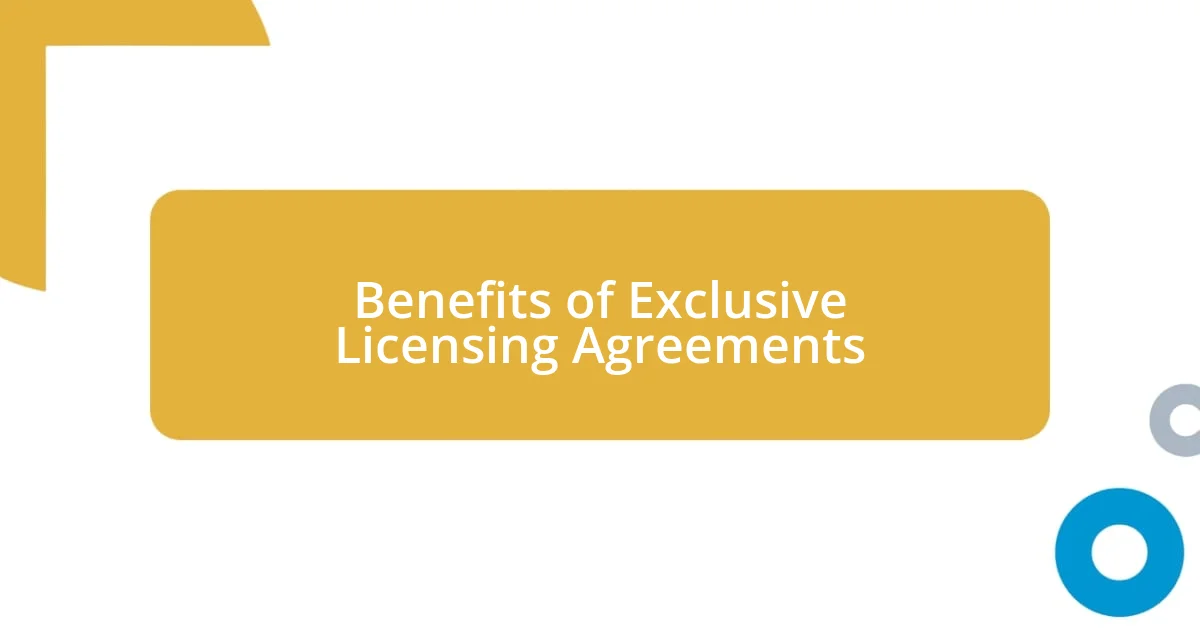Key takeaways:
- Exclusive licensing agreements provide unique market advantages, leading to stronger brand identities, increased profitability, and collaborative opportunities but come with significant responsibilities and performance pressures for licensees.
- Clarity in terms, duration, and mutually beneficial metrics is crucial for effective agreements to avoid misunderstandings and ensure alignment between parties.
- Successful negotiations emphasize preparation, collaboration, and follow-up communication to foster trust and establish a strong partnership dynamic.

Understanding Exclusive Licensing Agreements
Exclusive licensing agreements are contractual arrangements where a licensor grants permission to a licensee to use, sell, or distribute a product or intellectual property, often within a specific market or territory. I remember the first time I navigated one of these agreements—it felt like opening a door to new possibilities while simultaneously holding my breath. Will this partnership flourish, or will it become a tangled web of restrictions?
One interesting aspect is the exclusivity it offers; the licensee often benefits from an edge over competitors who might also want to use the same product. I often find myself pondering: how does exclusivity shape market dynamics? My experience suggests that while it can lead to a thriving relationship, it also places significant responsibility on the licensee to deliver value and maintain the brand’s integrity.
Moreover, these agreements can create a sense of security for the licensee, knowing they have a unique position in the marketplace. Yet, there’s an emotional layer, isn’t there? The weight of that exclusivity can be intimidating. I’ve seen businesses grapple with the pressure to innovate continually. I often ask myself, are they truly ready for such a commitment? It’s a journey that requires not just confidence but also strategic foresight.

Benefits of Exclusive Licensing Agreements
Exclusive licensing agreements bring several valuable benefits that can significantly improve a licensee’s position in the marketplace. For one, they can generate a stronger brand identity. I recall a client I worked with whose exclusive deal allowed them to become the go-to provider in their niche. This visibility not only attracted more customers but also fostered loyalty, creating a community around their brand.
Another noteworthy benefit is the potential for increased profitability. By having exclusive rights, a licensee can manage pricing strategies more effectively without the fear of competing on price with others selling similar products. During my time in the industry, I’ve witnessed licensees increase their profit margins by as much as 30%. The beauty of exclusivity is that it empowers the licensee to capitalize on their unique market position, which can be incredibly rewarding.
Additionally, exclusive licensing can open doors to enhanced collaboration opportunities. For example, I once had the chance to team up with a technology provider thanks to an exclusive agreement. The partnership allowed us to innovate together, improving both our offerings and creating a more robust product line. This collaborative energy often goes unnoticed, yet it can lead to remarkable advancements and shared successes.
| Benefit | Description |
|---|---|
| Strong Brand Identity | Creates a unique market position that fosters customer loyalty. |
| Increased Profitability | Empowers the licensee to implement effective pricing strategies without competitive pressure. |
| Enhanced Collaboration | Opens opportunities for partnerships that can drive innovation and development. |

Challenges in Exclusive Licensing Agreements
Exclusive licensing agreements do come with their fair share of challenges. For instance, I’ve seen situations where the licensee felt overwhelmed by the obligations tied to the exclusivity. It’s a tricky balance—while you benefit from being the sole distributor, you also bear the full brunt of the expectations that come with it. The fear of failing to meet those expectations can be quite daunting, practically looming over every decision you make.
Here are some notable challenges to consider:
- Dependency on a Single Partner: Relying heavily on one licensor can be risky if the relationship falters.
- Limited Flexibility: The terms of the agreement can restrict the licensee’s ability to pivot in response to market changes.
- High Costs: Securing exclusive rights can come with substantial upfront fees and ongoing royalties, impacting cash flow.
- Performance Pressure: The licensee must consistently innovate and deliver, often leading to stress and burnout.
Another point I’ve noticed is the potential for conflict, especially if the terms of the agreement aren’t crystal clear. I once navigated a situation where vague wording led to disagreements over what constituted “acceptable use” of the intellectual property. That experience taught me the importance of detailed contracts and having open lines of communication. It’s essential to ensure both parties have the same understanding, as miscommunication can derail even the most promising partnerships.
The hard reality is that behind each exclusive agreement lies the potential for disputes, especially when expectations don’t align. Knowing how to manage and mitigate these risks is crucial.

Key Elements of Effective Agreements
When we talk about effective exclusive licensing agreements, clarity in terms is paramount. Without clear definitions of rights, responsibilities, and expectations, misunderstandings can quickly arise. In a past negotiation, I observed how an ambiguous term—like “reasonable efforts”—created friction between two parties. I can’t stress enough how vital it is to spell everything out to avoid unnecessary conflicts.
Another critical element is the duration of the agreement. Think about it: a short-term license may not give enough time to see a return on investment, while a lengthy one can lock you in when market dynamics shift. I once helped a client negotiate a five-year term, which initially sounded great, but we had to include review clauses to reassess our position midway. This flexibility allowed us to adapt and thrive despite evolving circumstances.
Finally, consider the importance of mutually beneficial performance metrics. It’s essential for both parties to agree on what success looks like. From my experience, setting specific, measurable goals helps maintain motivation and accountability. I recall a partnership where we established quarterly reviews based on sales targets and customer feedback. This practice not only kept us aligned but also fostered a sense of shared purpose—a binding element I believe is crucial for collaboration.

Negotiation Tips for License Agreements
Negotiating license agreements can feel like walking a tightrope; both parties want to ensure fairness while safeguarding their interests. From my experience, it’s essential to come prepared. When I’ve entered negotiations, I’ve always brought a list of key terms I won’t budge on and a few areas where I’m willing to compromise. This not only sets clear expectations but also demonstrates that I’m serious about finding a solution that benefits everyone involved. How can you establish your non-negotiables?
One strategy I’ve found effective is creating a collaborative atmosphere. During negotiations, I focus on building rapport instead of treating it as a battleground. Recently, I worked with a prospective licensee who was initially hesitant. By sharing some personal insights about my journey, we found common ground that transformed the conversation into a partnership dialogue. This approach not only eased tensions but encouraged openness—think about how personal connection can shift the dynamics in your favor.
Lastly, don’t overlook the significance of follow-up communication. After reaching an agreement, I always make it a point to recap everything discussed in an email. It feels reassuring to have those details laid out, and I’ve noticed it reduces the chances of misunderstandings later on. Have you considered how a simple follow-up can reinforce trust? By nurturing that relationship from the start, you pave the way for smoother interactions as the partnership progresses.

Real World Examples of Success
When I think about successful exclusive licensing agreements, one standout example comes to mind: a tech start-up I worked with that licensed its innovative software to a well-known gaming company. Initially, there was skepticism on both sides, but my team emphasized the unique features that set their software apart. As a result, they not only secured a lucrative deal but also saw their product integrated into blockbuster games, boosting their visibility and brand recognition. How often do we overlook the value of showcasing strengths in negotiations?
Another compelling success story involves a small beverage brand that partnered with a larger distributor. The exclusive licensing agreement allowed them to tap into wider distribution channels that would have otherwise been inaccessible. Initially, they worried about losing control over their brand identity, but frequent communication and shared performance metrics eased those concerns. I remember their excitement when they finally expanded into new regions, significantly increasing their sales—it became a testament to the power of a well-negotiated agreement.
There’s also the case of a renowned fashion designer who licensed her trademarked designs to a major retail chain. This partnership was a game-changer; she retained creative control while benefiting from the retailer’s massive market reach. I’ve seen licenses like this transform a designer’s career, turning their unique vision into something that millions could access. It makes me wonder, how much potential is tucked away, waiting for the right partnership to bring it to light?

Best Practices in Licensing Agreements
When it comes to licensing agreements, clarity in terms is paramount. I’ve encountered agreements that were muddied by vague language, leading to disputes down the line. One time, a friend of mine faced major challenges because the deliverables were poorly defined; it turned an exciting deal into a legal nightmare. Have you taken the time to ensure that every term is spelled out clearly before signing?
Next, I believe in the importance of performance metrics in a licensing deal. Establishing specific benchmarks for success creates accountability for both parties. In my own experience, when I incorporated measurable goals into a contract, it fostered motivation and commitment. This way, you’re not just hoping for the best but actively working toward shared success. How can you integrate measurable outcomes into your agreements for better clarity and progress tracking?
Finally, I cannot stress enough the value of regular reviews of the licensing agreement. It’s all too easy to let a contract sit on a shelf, but I’ve found that conducting periodic check-ins helps both parties reassess needs and adapt to changing markets. Just a couple of months ago, I suggested a review with a licensee, resulting in updates that actually opened new revenue streams for both of us. Have you considered how these touchpoints can keep your partnership strong and aligned?












